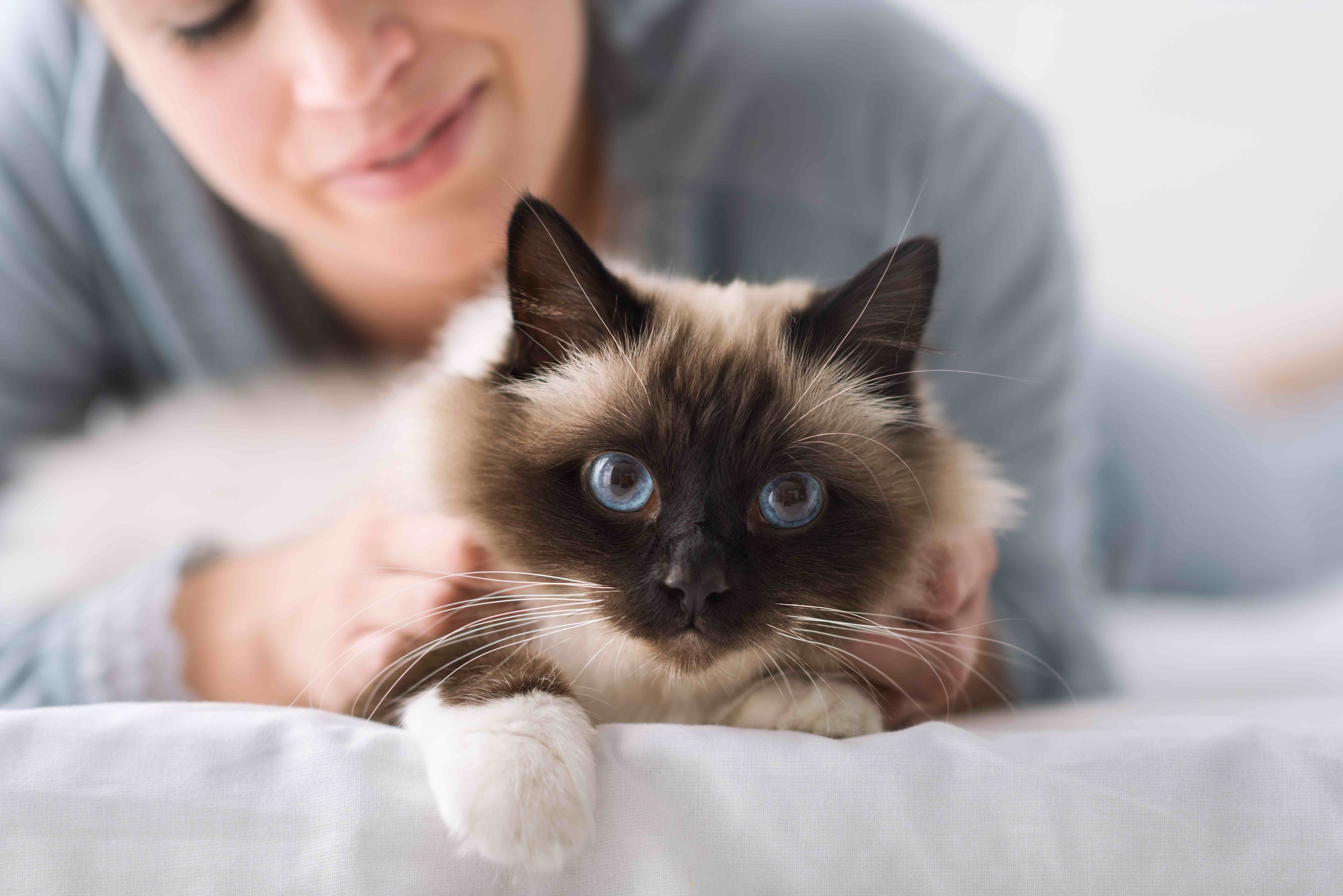Birman
Adobe Stock/vika_hova
As the Birman cat legend goes, there were once 100 golden-eyed temple cats with long white fur and mittened paws the color of Earth. Upon the tragic death of the temple’s high priest, who spent his days worshiping a blue-eyed goddess, a loyal cat named Sinh touched him and miraculously transformed. Sinh's fur turned golden, eyes sapphire blue, and paws pure white. It's said all the cats followed suit, earning the Birman cat the nickname Sacred Cat of Burma.
Outside of legends, the origin of the blue-eyed, white-mittened Birman cat remains a mystery. The cats made their way from Burma (now Myanmar) to France in the early 20th century. They’re medium-sized cats (about 12 pounds) with calm temperaments and friendly personalities, making them a great choice for both new and experienced cat parents.
Caring for a Birman
The Birman is a friendly cat breed that loves their people … and any other people who stop by to say hello. “Some say they are dog-like in their personalities, always your loyal best friend,” says Diane Coppola, president of National Birman Fanciers, a member of the Birman Breed Council, and head of NBF’s Birman Rescue.
While their hair is long, it’s silky smooth and doesn’t tend to mat. Coppola recommends brushing your Birman a few times a week; they'll likely enjoy the attention.
Birman Health Issues

While known for being a healthy breed with a lifespan of 9–13 years, purchasing a kitten from a reputable Birman cat breeder helps ensure good health from the start.
Birmans have a few potential health issues. Meeting your cat’s nutritional needs and routinely seeing your veterinarian for wellness checkups can help you stay ahead of potential health conditions.
Hypertrophic Cardiomyopathy
Birman cats can be susceptible to hypertrophic cardiomyopathy (HCM), the most common heart disease among cats. HCM thickens the heart wall, making it harder to pump blood. The early stages are often easily missed because cats might not show any symptoms, but some will have audible heart murmurs. As the disease progresses, it can lead to coughing, shortness of breath, lethargy, and heart failure.
While genetic testing for HCM in Birman cats isn't available yet, regular veterinary checkups can help detect the condition early. HCM is incurable, but specialized treatment plans can manage symptoms and improve your cat's well-being.
Polycystic Kidney Disease
The kidneys are crucial for filtering waste from the body, producing essential hormones, and regulating the body’s balance of fluids, minerals, and electrolytes. In cats with polycystic kidney disease (PKD), cysts develop in the kidneys, leading to permanent damage and decreased function.
Fortunately, Birmans can be genetically tested for PKD. If you’re working with an experienced Birman cat breeder, ask if both of your kitten’s parents have been genetically tested for the disease. Affected cats should not be bred.
What To Feed a Birman

“Feeding high-quality food is essential for any cat, and Birmans are no exception,” Coppola says. High-quality cat foods will have an Association of American Feed Control Officials (AAFCO) statement on the cat food label. This statement means the food meets the minimum nutritional requirements that are recommended for your cat’s life stage (kitten, adult, or senior).
Your veterinarian can guide you in choosing the best food for your cat. As your Birman cat reaches their senior years, your veterinarian may recommend transitioning to a senior cat food diet.
How To Feed a Birman
Birman cats tend to do best with at least two meals a day. Opting for wide bowls can provide plenty of room for their sensitive whiskers and reduce the likelihood of whisker fatigue.
While Coppola says her Birmans aren’t enthusiastic about working for their food, puzzle toys can be enjoyable and enriching for many cats. These toys mimic a cat’s natural foraging and hunting behaviors, providing mental stimulation and slowing down fast eaters.
How Much Should You Feed a Birman?
Your veterinarian can recommend a daily caloric intake based on your cat’s age, lifestyle, health, and current and ideal weight. In the meantime, feeding guidelines on the back of cat food packaging can be a good starting point for portioning your cat’s serving sizes.
Nutritional Tips for Birman Cats
A complete and balanced cat food meeting the AAFCO’s nutritional recommendations contains all the vitamins, minerals, and essential nutrients your cat needs. However, some cats can benefit from supplements or specialized diets based on their health.
For example, Coppola feeds her long-haired Birmans hairball prevention cat food, while senior cats might benefit from a diet enriched with omega fatty acids.
Before switching your cat to a specialized diet or adding supplements to their food bowl, consult your veterinarian.
Behavior and Training Tips for Birmans
Birman Cat Personality and Temperament
Birman cats have affectionate and easygoing personalities. Coppola describes them as "loving, outgoing, friendly, and sweet." They enjoy spending time with people and other household pets, making them adaptable to a variety of homes. However, proper introductions and teaching kids how to interact with pets are key to a happy home.
Birman Behavior
Dog-like in personality, Birmans are your loyal best friend, Coppola says. While they might not always cuddle on your lap, they love companionship and following their humans from room to room.
Birmans are also playful cats with a talent for climbing. “They can scale the highest cabinet, which can be a challenge,” Coppola says.
Providing plenty of safe climbing surfaces such as cat trees, shelving, and perches can help keep your Birman out of trouble and off your counters. These slow-to-mature cats retain their playful kitten personalities well into their third or fourth year before settling into a calmer demeanor.
Dog-like in personality, Birmans are your loyal best friend. While they might not always cuddle on your lap, they love companionship and following their humans from room to room.
Birman Training
Playful and intelligent, Birmans can learn (and love) to fetch toys. In fact, cats can learn all sorts of tricks when clicker training is used with positive reinforcement.
Fun Activities for Birman Cats
-
Fetching
-
Climbing
-
Being groomed
-
Lounging in a secure catio
-
Spending time with other pets and people
Birman Grooming Guide
Birman cats have four white paws and "white laces running up their back legs," Coppola explains. They’re colorpoint cats, meaning their bodies are white or off-white while their tail, face, and legs are a contrasting hue of grays and browns. Hallmark Birman cat colors include cream, beige, and tan.
Their grooming needs are relatively simple, although they can vary based on the fullness of their fur.
Skin Care
According to Coppola, Birman cats often enjoy playing in their water bowl or drinking from the sink faucet. However, bathing is not a necessary part of your Birman’s grooming routine.
Monitor your Birman’s fur for signs of skin problems like redness, itchiness, dryness, or flea dirt (small black spots). If you notice any of these, schedule a vet visit.
You can prevent parasites such as fleas and ticks by staying up to date on monthly parasite preventives; even indoor cats require protection.
Coat Care
Although they have silky hair that tends to tangle and mat less than other long- to semi-long-haired cat breeds, brushing your Birman with a slicker brush a few times a week will reduce shedding and hairballs as well as prevent mats from forming. They also tend to enjoy the pampering, Coppola says.
Eye Care
Birmans’ dazzling blue eyes don't require special care outside of watching for signs of common eye problems in cats, like redness and irritation, or excessive discharge. If you spot these signs, see your veterinarian to rule out or treat them for an eye infection or injury.
Ear Care
Check your cat’s ears for any debris or foul smell. Your veterinarian can demonstrate how to safely clean your cat’s ears, or treat ear mites and infections.
Nail Care
To get your cat accustomed to regular nail trimmings, Coppola recommends starting a nail grooming routine when your Birman kitten is young.
Considerations for Pet Parents

Birmans have affectionate and playful personalities, making them an ideal fit for a variety of households, including those that are extra social or include children and other pets—as long as you take the time for proper introductions.
While Birmans aren’t high-maintenance cats, prospective pet parents should have ample time to brush their Birman’s silky fur a few times a week and play with them daily. To accommodate their love of climbing, provide your Birman cat or kitten with plenty of cat trees and shelves. These loyal companions remain playful well into adulthood, so get ready for years of entertainment.
Birman FAQs
Do Birman cats make good pets?
According to Coppola, Birmans have an easygoing nature that makes them wonderful pets for families and singles alike. With proper introductions, they’ll happily live and play with children and other pets.
Are Birman cats high-maintenance?
Birman cats are relatively low-maintenance. Their silky fur isn't prone to mats and tangles—however, brushing a few times a week keeps their fur healthy while reducing shedding and hairballs.
Are Birman cats expensive?
Birman cat prices start at around $1,500 for a kitten.
Why are Birman cats rare?
Stories of the Birman cat begin in the temples of Burma (now Myanmar), but documented history only traces back to their arrival in France in 1925, according to the Birman Council. When the first Birman cats arrived in France, they were very rare. Their high price tags (they were considered a luxury pet in 1920s France) coupled with the effects of the war likely cemented their status as a rarity.
Are Birman and Ragdoll cats the same?
Birman and Ragdoll cats may appear similar at first glance, thanks to their silky colorpoint fur and dazzling blue eyes. However, they are two distinct breeds.
While both have medium to long hair, the Ragdoll tends to be a larger cat with a more muscular build. Their personalities differ, too: Ragdolls are known for their relaxed and affectionate nature, often going limp when held. Birmans, while friendly, are not as keen on cuddling.
